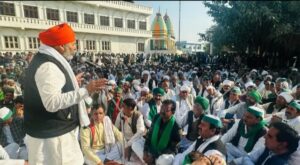
Intoduction:
The kisan Andolan, a movement that gripped the nation’s attention with its fervor, has entered a new phase- Kisan Andolan 2.0. Originating from the farmer’s protest against the three laws, the movement has evolved, presenting a complex narrative that extends beyond agricultural reforms. Amidst this, the presence and accusations of Khalistani elements have added layers of complexity to the discourse surrounding the protests.
A Recap Of Kisan Andolan:
The Kisan Andolan, which gained momentum in late 2020, centered around the farmers opposition to the farmers produce trade and commerce Act, the farmers agreement on price assurance and farm services act, and the essential commodities act. The farmers expressed concerns about the potential exploitation by corporations, the absence of guaranteed minimum support price(MSP), and the perceived threat to their traditional livelihoods.
Kisan Andolan 2.0: The Evolution:
As the protest continued, they underwent a transformation, leading to what can be termed Kisan Andolan 2.0. What started as a focused movement against farm laws began to encompass broader socio-political issues. The agitation evolved beyond the demand for repelling the farm laws to include discussions about the state of democracy, corporate influence, and socio-economic inequality.
The Khalistani Angle:
Amidst this evolution, the protest sites became a stage for a multifaceted narrative. Accusations of the involvement of Khalistani elements- individuals advocating for an independent Sikh state- surfaced, further complicating the already intricate discourse. Some critics argue that the movement has been infiltrated by elements, with a separatist agenda, pointing to flags and slogans associated with Khalistani ideology visible at protest sites.
Understanding Khalistani Assertions:
It’s crutial to approach the Khalistani accusations with nuance. While there may be instances of individuals with Khalistani sympathies participating in the protests, it is essential not to generalize the entire movement. The overwhelming majority of the protesters are farmers voicing their concerns about agricultural policies. However, the presence of Khalistani elements has provided the legitimacy of the entire movement.
Navigating the Complex Narrative:
As Kisan Andolan 2.0 unfolds, it becomes imperative to navigate the complex narrative carefully. On one hand, the movement represents the collective voice of farmers advocating for their rights and a secure future. On the other hand, the allegations of Khalistani influence raise questions about the broader implications of the protest and their potential impact on national unity.
Social Media Amplification:
The role of social media in shaping the narrative cannot be overlooked. Accusations, counter-accusations, and various perspective on the khalistani angle have circulated widely, contributing to the polarization of opinions. If is essential for the public to critically evaluate information and discern between genuine concerns and attempts to discredit the movement.
Government’s Response:
The government has been actively engaged in dialogue with the farmers, attempting to address their concerns and find common ground. However, the impasse persists, with the farmers insisting on a complete repeal of the farms laws. The governments response to the khalistani allegations has been to emphasize the need to differentiate between genuine farmers and those with ulterior motives.
The Way Forward:
As Kisan Andolan 2.0 continues to unfold, it is crucial for all stakeholders to engage in constructive dialogue. Addressing the core concerns of the farmers, ensuring transparency in communication, and acknowledging the diversity of voices within the movement are essential steps. Simultaneously, efforts to identify and isolate any elements with separatist agendas should be undertaken to maintain the integrity of the protest.
Conclution:
Kisan Andolan 2.0 represents a complex chapter in India’s socio-political landscape. The evolution from a focused farmers protest to a broader movement encompassing diverse issues has brought both challenges and opportunities for dialogue. Navigating the narrative requires a careful examination of the genuine concerns of the farmers while addressing allegations of external influences. As the nation grapples with these complexities, the need for open communication, empathy, and a commitment to democratic values becomes increasingly evident.

